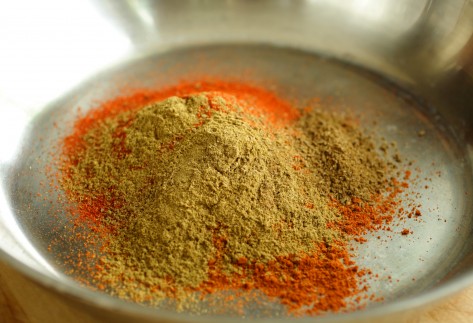Pilpelchuma

Tucked in the back of the cookbook Jerusalem by Yotam Ottolenghi and Sami Tamimi, in the condiment section, is pilpelchuma, a potent chile-and-garlic paste that is often compared to Tunisian harissa. Also spelled pilpelshuma or filfel chuma, it means “pepper garlic.” An apt name considering that in Ottolenghi and Tamimi’s version contains 20 cloves of garlic and 4½ tablespoons of cayenne pepper.
Ottolenghi and Tamimi do not use pilpelchuma in a recipe in Jerusalem, but instead give a couple of suggestions for its use. They suggest smearing it over root vegetables before roasting, mixing it with oil and herbs to marinate meats for the grill, or whisking it into eggs when making scrambled eggs. They advise using it carefully as it is concentrated in flavor and chile heat.
In inspired by its deep, spicy flavor, I came up with two uses for pilpelchuma: a potato-and-egg scramble, which uses a sensible amount of the powerfully flavorful paste; and marinated and grilled chicken, which uses quite a bit more, ranging from mild to hot, HOT, HOT.
The recipe for pilpelchuma is not one that the book’s publisher would grant me use of, so you’ll have to get a hold of a copy of Jerusalem if you want to make it. There is a version online, here, but there are differences between the two. The online version uses lemon juice whereas the Ottolenghi and Tamimi’s recipe does not, and the Jerusalem version has lots more garlic and cayenne plus an added flavor boost derived from toasting the dried spices and from using dried ancho or pasilla chiles.
CORRECTION – July 2, 2013:
Contrary to what I wrote above, pilpelchuma is used in a couple of recipes in Jerusalem: Spicy Carrot Salad and Shakshuka. DCCC members Melanie and Diane pointed this out to me when we three started talking about the crazy spice level of the paste. This is a sign of a poor index. When you look up pilpelchuma in the Jerusalem index, the only entry is for the paste. I’ve noticed that many cookbook indices have become shorter over the last several years, no doubt to save paper costs when print margins are being eroded by online sites and increasingly e-media. But this is the worst possible time to make indices less thorough. Just think about how easy it is to search for information online. The last thing you want to do is frustrate your print user. The upside of my misapprehension is that had I known that pilpelchuma is used in recipes in the book, I may not of come up with my own uses for it. And recipe development is always fun.

The ground spices used in pilpelchuma—cayenne pepper, sweet paprika, ground cumin, and ground caraway seeds—are toasted to enhance flavor.

The Jerusalem Cookbook is awesome. I purchased it from Amazon.com. Love the beautiful photography, and insights it provides. I´ve made the Pilpelchuma, the falafels, but I did not fry them. I rollled them in sesame seeds and baked the falafels. I also made the watercress soup with garbanzos.
As for the recipe, there are various recipes on line for Pilpelchuma. Here´s one: http://thisupsidedownlife.blogspot.com/2014/01/some-like-it-hot-pilpelchuma.html
1Thanks for sharing a link to a pilpelchuma recipe, Gloria. I appreciate you sharing resources like that–it makes for a better read for everyone.
2It is a fantastic book, isn’t it? Simply learning to make a proper batch of hummus is worth the purchase. Thanks for sharing the link to pilpelchuma. That makes my posting more useful. One day I’d like to explore Spanish food with the club–once I get it resurrected in my new home. What are your top three favorite Spanish cookbooks?
3I have a dry mix of pilpechuma and am looking for recipes which use this spice. Anyone have a good recipe to share, outside of the cookbook mentioned?
4Cookbook indices are getting shorter and less useful not because the paper to print them on is so expensive, but because cookbook editors—and more generally, indexers of all subjects—are too expensive.
5That’s a great point, and one that I hadn’t thought of. Although, I don’t think I’m too expensive . . . 🙂
6Hi Paula,
7Aside from the two recipes I linked to in my posting, plus those in the cookbook, I don’t know of any other recipes. But I friend of mine used it to season a turkey Thanksgiving. She rubbed it all over the turkey and underneath the skin. I got to sample some and it was excellent.